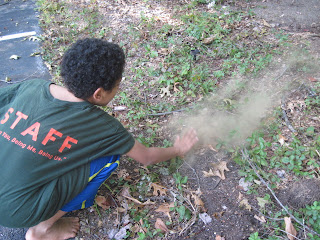I don't think there's "too old" to have fun making puffs of "smoke" come out of a puffball. So when I spotted this patch of puffballs growing at the edge of the parking lot, a little childhood thrill went through my heart.
 | |||||
| Puffballs, one of my favorite fungi (Photo credit (c) 2012 Kim Bennett) |
What's a Puffball?
Puffballs are mushrooms that are shaped like a somewhat round "egg", that release their spores through a pore at the top of the "egg," when mature. They are attached to the ground by mycelium, as are the gilled mushrooms.Puffballs can be confused with the immature forms of other mushrooms. However, when you slice the mushroom in half, a puffball will just be flesh (if immature, like this giant puffball my little guy whacked open on a nature walk last year [top]), or will be a hollow sphere full of spores (if mature, like the ones in the bottom photo, below).
 |
| Immature puffballs have just creamy flesh inside (c) 2010, Kim M. Bennett |
 | |
| Mature puffballs are hollow "shells," with only spores inside. (c) 2012, Kim M. Bennett |
In this photo, you can see the "buds" of a new crop of stinkhorns, alongside one that is emerging. You can see that the "shell" is a leathery or papery sheath that encapsulates the stem and head of the stinkhorn (see the remnants of the shell in the stinkhorn to the left). What you can't see in the photo is that the shell is also full of a nasty gel -- not easily confused with the contents of the immature puffball, above.
 |
| Stinkhorn "eggs," in cross-section, reveal the stinkhorn within, encased in a gelatinous matrix. (c) 2011 Kim M. Bennett |
Gilled mushrooms, as well, reveal the upcoming mushroom in cross-section, as an "outline" of the major veins of the fruiting body. The Mushroom Expert has a great photo of a poisonous Amanita in cross-section, showing the outline of the mushroom within the egg.
Why Call Them "Puffballs?"
Puffballs do not have gills -- they don't look like "toadstools" with a stem and a cap. In contrast, their spores develop inside the capsule of the puffball. When mature, it takes only a puff of wind, the tread of a creature, or (better yet) the taps of raindrops to release the spores into the air, emerging from the pore at the top.Of course, little boys (and their moms) can also help...
 |
| (c) 2012, Kim M. Bennett |
 |
| (c) 2012, Kim M. Bennett |
 | |||
| (c) 2010, Kim M. Bennett |
Studying Puffballs
Puffballs make a great study for "One Small Square" activities, as there's a lot going on in a small area (check out the photos, above). Because they develop quickly, you can revisit the same spot quickly, over the course of a couple of weeks, and see things changing (good for working with little ones who need quicker change). Our crop of puffballs emerged and matured within a few weeks' time. Even after they matured, the shells of the puffballs remained for a long time, and were fascinating to my 8-yr-old, who always managed to get a few more spores out of them![Submitted to the Simple Science Strategies September Blog Carnival, and the Outdoor Hour Challenge September Blog Carnival]
Stay Tuned...
My All-Season Indoors Kitchen Composter (fueled with bokashi) arrived! Stay tuned for a review of this product (from UncommonGoods) in a couple of weeks (I'm very excited -- anything to stretch the gardening theme into the fall and winter...). |
| The All-Seasons Indoor Composter, $48 from UncommonGoods |
Nadene at Practical Pages shares a hollow log indoor garden, complete with little honey mushrooms, that one of her children created for a homeschool learning project -- see it at "Freedom Homeschool Brings."
Will you help me out?
Will you help me out? Please click on the link below to answer a short, 8-question survey about your experience on my blog. No ads! Just information for me. Thanks so much!
Take the October 2012 Reader Survey now.






















